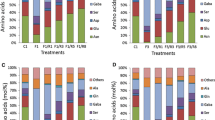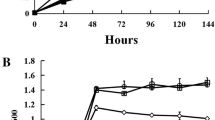Abstract.
Several markers of oxidative stress were measured in 2- to 10-week-old soybean (Glycine max [L.] Merr.) nodules. There were increases in peroxides, protein carbonyls and modified DNA base concentrations with nodule age. The catalytic iron content also increased significantly during nodule ageing. Iron contained in the peribacteroid space was effective in promoting lipid peroxidation and this might contribute to the degradation of the peribacteroid membrane in senescing nodules. The concentration of the oxidized forms of glutathione and homoglutathione increased significantly during nodule development and the concentration of reduced glutathione and homoglutathione decreased during senescence. Taken together, these results are consistent with the development of oxidative stress in senescing nodules. Significant DNA and protein damage also occurred in the first days of nodule development, suggesting that an earlier period of oxidative stress might occur in the period over which the symbiosis becomes established.
Similar content being viewed by others
Author information
Authors and Affiliations
Additional information
Received: 7 July 1998 / Accepted: 30 November 1998
Rights and permissions
About this article
Cite this article
Evans, P., Gallesi, D., Mathieu, C. et al. Oxidative stress occurs during soybean nodule senescence. Planta 208, 73–79 (1999). https://doi.org/10.1007/s004250050536
Issue Date:
DOI: https://doi.org/10.1007/s004250050536




